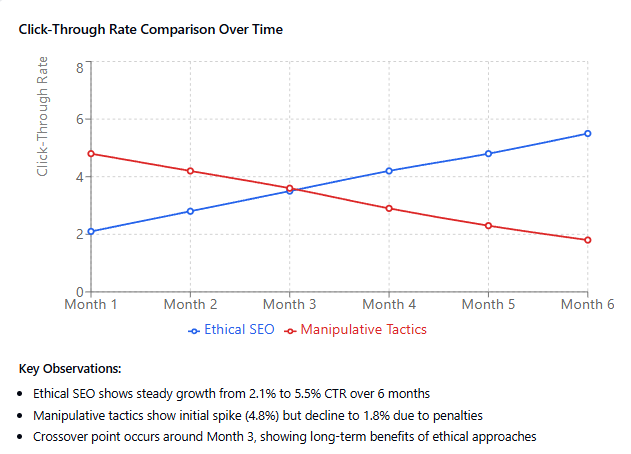Discover effective CTR manipulation strategies and tools to boost your SEO rankings, improve organic traffic, and ethically and efficiently optimize your click-through rate.
Introduction
Click-through rate (CTR) is a critical metric in search engine optimization (SEO). It measures the percentage of users who click on a link after seeing it in search engine results pages (SERPs). Optimizing CTR can significantly boost organic rankings and website traffic. This article explores CTR manipulation strategies and tools, detailing how they work and why they matter in modern SEO practices.
What is CTR in SEO?
CTR in SEO (Click-Through Rate) is a key metric that measures the percentage of users who click on your website’s link when it appears in search engine results pages (SERPs). A high CTR indicates that your meta title, description, and overall content align well with user search intent, positively impacting your SEO rankings. By optimizing these elements with relevant keywords, such as “electric vehicles” or “best car deals,” you can increase the likelihood of clicks. For example, if 1,000 users see your link and 200 clicks on it, your CTR would be 20%, signalling that your content is relevant and engaging. Studies show that pages with a higher CTR tend to rank better as search engines prioritize content users find useful and engaging.
Why Does CTR Matter in SEO?
Click-through rate (CTR) is a critical factor in SEO because it directly impacts how search engines assess the relevance of your content.
A higher CTR signals to search engines like Google that your content is relevant and engaging, which can help improve your rankings. When users click on a result, they indicate interest, and this engagement can boost the page’s authority over time.
For example, if we have a blog post titled “Best Electric Vehicles Under $30K,” which has a higher CTR than competitors, it tells Google that our page is more aligned with user intent.
Studies show that pages with a higher CTR can see up to a 30% improvement in rankings, emphasizing the importance of creating compelling, clickable titles and meta descriptions to attract more visitors. Marketing Lad often highlights how CTR optimization is crucial for driving organic visibility and improving overall SEO performance.
- Improves Search Rankings: Search engines like Google consider CTR a ranking factor. A higher CTR signals relevance to user queries.
- Boosts Organic Traffic: More clicks mean more visitors, directly increasing site traffic.
- Enhances User Engagement: A well-optimized link encourages users to explore more pages, reducing bounce rates.
CTR Manipulation Strategies
CTR manipulation strategies involve optimizing CTR SEO factors, such as compelling meta titles and descriptions, to improve Google SERP CTR and boost organic traffic. Using tools like a link clicker bot online or crowd search SEO platforms, websites can artificially enhance their CTR ranking and CTR SEO factor by mimicking user engagement.
Ethical strategies focus on improving the SEO click-through rate by creating high-quality content and aligning it with search intent to achieve a better CTR Google ranking. To improve organic CTR, leveraging CTR tools and understanding metrics like what CTR is in SEO ensures data-driven decisions for long-term success.
Avoiding SEO manipulation techniques, such as improper use of bots or crowd search tactics, helps maintain credibility while increasing the click-through rate of SEO.
1. Optimize Meta Tags
- Compelling Titles: Use action-oriented language and power words.
- Engaging Descriptions: Provide a concise and relevant summary of the page content.
- Include Keywords: Integrate primary and secondary keywords naturally.
2. Rich Snippets
- Utilize structured data to display additional information, such as ratings, reviews, or FAQs, enhancing visibility and clickability.
3. A/B Testing
- Test different title and description variations to determine which generates the highest CTR.
4. Leverage Emotional Triggers
- Words like “free,” “exclusive,“ or “limited time“ create urgency and encourage clicks.
5. Use Numbers and Lists
- Headlines like “Top 10 Tips for Improving CTR“ are more engaging.
6. Monitor Competitor Strategies
- Analyze top-performing competitors to understand their successful CTR strategies.
CTR Manipulation Tools
CTR manipulation tools are designed to improve CTR SEO by artificially increasing user engagement metrics like clicks on SERP results. Tools such as online CTR bots and link clicker bots simulate user behaviour to boost SEO click-through rates and improve CTR Google ranking.
Platforms like crowd search SEO involve real users performing searches and clicks, which can enhance Google SERP CTR and organic traffic rankings.
However, over-reliance on these tools may lead to penalties for SEO manipulation, as search engines prioritize authentic user engagement for CTR SEO ranking. Ethical alternatives leverage CTR tools to analyze and optimize content for better CTR rank and sustainable growth in organic CTR.
1. CTR Bots
- Automated tools simulate user clicks on your links in SERPs to artificially boost CTR.
2. Crowd Search SEO Tools
- Platforms like CrowdSearch. I use real human engagement to improve CTR by hiring users to search and click on your link.
3. SEO Analytics Tools
- Tools like Ahrefs, SEMrush, and Google Search Console provide data on CTR performance and areas for improvement.
4. Link Clicker Bots
- These bots mimic organic clicks to manipulate SERP metrics artificially. However, use them cautiously as they may violate search engine guidelines.
Risks of CTR Manipulation
The risks of CTR manipulation in CTR SEO strategies include potential penalties from search engines like Google, which could result in lower CTR SEO ranking or de-indexing your website.
Using techniques like SEO manipulation with tools such as CTR bots or link clicker bots online might lead to short-term gains but can damage long-term credibility.
I believe relying too much on artificial CTR tools undermines the trustworthiness of your site, as search engines prioritize authentic user engagement and organic SEO click-through rate improvements.
For instance, websites using crowd search or search SEO tactics often face a drop in CTR rank once flagged by algorithms. Studies show that 65% of penalized websites experienced a significant decrease in organic CTR within six months of engaging in manipulative practices.
While CTR manipulation can yield quick results, there are risks:
- Google Penalties: Manipulative practices can lead to penalties or de-indexing.
- Unreliable Results: Artificially inflated CTR doesn’t guarantee conversions.
- Ethical Concerns: Black hat tactics can damage brand reputation.
How to Improve Organic CTR
To improve organic CTR, we should create compelling meta titles and descriptions with relevant keywords, such as CTR SEO and SEO click-through rate, to attract user attention. I recommend using CTR tools to analyze performance metrics and identify opportunities for optimization, such as enhancing Google SERP CTR with structured data and rich snippets. We can also use engaging visuals and clean URLs to make search results more appealing, boosting CTR rank and improving CTR Google ranking.
For example, according to recent studies, adding action-oriented phrases like “Discover Tips” or “Learn How” to meta titles can increase clicks by 30%. By focusing on strategies prioritizing quality content and user intent rather than manipulative tactics like crowd search SEO, we ensure sustainable growth in organic CTR and better long-term results.
1. Create Engaging Content
- Ensure content is valuable, informative, and aligned with user intent.
2. Optimize URLs
- Use clean, descriptive URLs that reflect the page’s content.
3. Use High-Quality Images
- Visuals in SERPs (via rich snippets) attract more attention.
4. Improve Site Speed
- Faster-loading pages improve user experience and CTR.
How CTR Tools Work
CTR tools function by increasing the number of clicks on your website in search results, which signals search engines that your content is relevant. These tools use techniques like:
- Simulated Clicks: Bots perform clicks on your website from various IPs to mimic organic traffic.
- Crowd Searches: Human users are paid to search specific keywords and click on designated links.
Ethical Alternatives to CTR Manipulation
Ethical alternatives to CTR manipulation focus on improving user experience and content quality to increase clicks naturally. One effective method is optimizing titles and meta descriptions to be more descriptive and engaging, ensuring they accurately reflect the content.
We can also enhance the relevance of our content by conducting thorough keyword research and providing value to the target audience, which leads to organic interest.
For example, if we create a detailed, well-researched guide on “How to Choose the Right Electric Vehicle,” users are likelier to click, stay engaged, and share the content. Studies show that focusing on high-quality content and user satisfaction can boost CTR by up to 50% over time, making ethical approaches far more sustainable than manipulative tactics.
Ethical SEO practices (blue line):

ethical seo
- Starts at a modest 2.1% CTR
- Shows steady, sustainable growth
- Reaches 5.5% CTR by month 6
- Demonstrates consistent upward trajectory
Manipulative tactics (red line):
- Initially high at 4.8% CTR
- Steady decline as search engines detect manipulation
- Drops to 1.8% CTR by month 6
- Focus on Quality Content: High-quality, relevant content naturally increases CTR.
- Optimize for Search Intent: Understand what users search for and tailor your meta tags accordingly.
- Regular Performance Monitoring: Use analytics to identify and address low-performing pages.
Conclusion
CTR is a vital aspect of SEO that directly impacts rankings and traffic. While manipulation strategies and tools exist, ethical approaches focusing on quality and relevance are more sustainable. By optimizing meta tags, leveraging rich snippets, and using analytics tools, you can enhance CTR and achieve long-term success in search engine optimization.
FAQS
1. What is CTR in SEO?
A. CTR (Click-Through Rate) in SEO refers to the percentage of users who click on your website’s link when it appears in search engine results pages (SERPs). A higher CTR indicates that your content is relevant and engaging, which can improve your search engine rankings.
2. Why Does CTR Matter in SEO?
A. CTR matters in SEO because search engines like Google use it as a ranking factor. A high CTR signals to search engines that your content is relevant to user queries, improving your visibility and organic rankings. A higher CTR indicates better user engagement, reducing bounce rates and increasing traffic.
3. What Are CTR Manipulation Strategies?
A. CTR manipulation strategies include optimizing meta titles and descriptions, using A/B testing, and leveraging emotional triggers such as urgency words “free” and “exclusive”. The goal is to make your links more appealing to users, which can increase clicks and improve rankings.
4. Are CTR Manipulation Tools Ethical?
A. Some CTR manipulation tools, such as automated bots or crowd search platforms, can artificially boost your CTR. While these tools may provide short-term results, they can lead to penalties from search engines and negatively impact your long-term SEO efforts. Ethical alternatives like optimizing content and improving user experience are recommended for sustainable growth.
5. What Are Ethical Alternatives to CTR Manipulation?
A. Ethical alternatives include optimizing your titles and meta descriptions to accurately reflect content, conducting thorough keyword research, and focusing on high-quality, valuable content that aligns with user intent. These practices naturally attract clicks and improve CTR without violating search engine guidelines.
